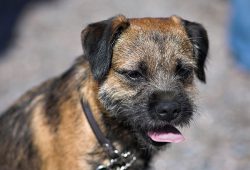The Border Terrier is a small, rough-coated breed of dog in the terrier group. Bred as a fox and vermin hunter, the Border Terrier shares ancestry with the Dandie Dinmont Terrier and the Bedlington Terrier.
The Border Terrier was officially recognized by The Kennel Club in Great Britain in 1920, and by the American Kennel Club (AKC) in 1930. The border terrier was bred to have long enough legs to keep up with the horses and other foxhounds, which traveled with them, and small enough bodies to crawl in the burrows of foxes and chase them out so the hunters had a blank shot. The foxhounds that traveled with them were not small enough to do the Border terrier’s job.
Description
Identifiable by their otter-shaped heads, Border Terriers have a broad skull and short (although many are fairly long), strong muzzle with a scissors bite. The V-shaped ears are on the sides of the head and fall towards the cheeks. Common coat colors are grizzle-and-tan, blue-and-tan, red, or wheaten. Whiskers are few and short. The tail is naturally moderately short, thick at the base and tapering.
Narrow-bodied and well-proportioned, males stand 13 to 16 in (33 to 41 cm) at the shoulder, and weigh 13 to 15.5 lb (5.9 to 7.0 kg); females 11 to 14 in (28 to 36 cm) and 11.5 to 14 pounds (5.2 to 6.4 kg). They are very versatile in families and as family pets.
Temperament
Though sometimes stubborn and strong willed, border terriers are, on the whole sound dogs, and are friendly and rarely aggressive. They are very good with children, but may chase cats and any other small pets.
Borders do well in task-oriented activities and have a surprising ability to jump high and run fast given the size of their legs. The breed has excelled in agility training, but they are quicker to learn jumps and see-saws than weaving poles. They take training for tasks very well, and are extremely trainable, and capable of learning tricks quickly and competently. The border in recent years has been bred to harbor a more subtle character so are more adaptable to apartment living if properly exercised.
They are intelligent and eager to please, but they retain the capacity for independent thinking and initiative that were bred into them for working rats and fox underground. Their love of people and even temperament make them fine therapy dogs, especially for children and the elderly, and they are occasionally used to aid the blind or deaf. From a young age they should be trained on command.
Health
Borders are a generally hardy breed, though there are certain genetic health problems associated with them, including:
- [wiki title=”Hip_dysplasia_(canine)” base=”EN”]Hip dysplasia[/wiki]
- [wiki title=”Legg–Calvé–Perthes_disease” base=”EN”]Perthes disease[/wiki]
- Various [wiki title=”Congenital_heart_defect” base=”EN”]heart defects[/wiki]
- Juvenile [wiki title=”Cataract” base=”EN”]cataracts[/wiki]
- [wiki title=”Progressive_retinal_atrophy” base=”EN”]Progressive retinal atrophy[/wiki]
- [wiki title=”Epileptic_seizure” base=”EN”]Seizures[/wiki]
- [wiki title=”Canine_epileptoid_cramping_syndrome” base=”EN”]Canine epileptoid cramping syndrome[/wiki] (CECS)
A UK Kennel Club survey puts their median lifespan at 14 years.
Border Terrier. (2017, June 17). In Wikipedia, The Free Encyclopedia. Retrieved from https://en.wikipedia.org/w/index.php?title=Border_Terrier&oldid=786161938


